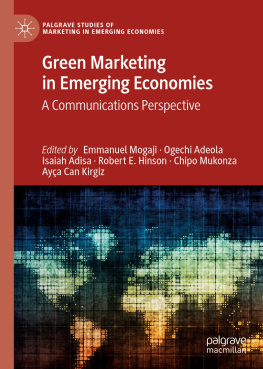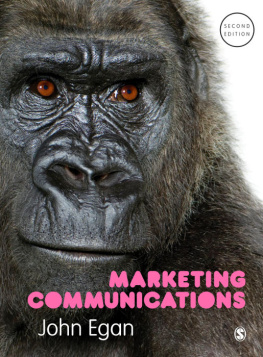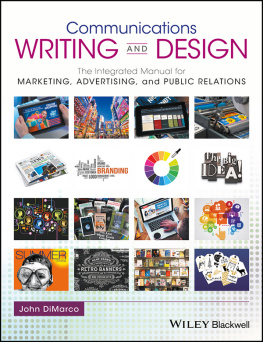Table of Contents

Great nuggets on how to convert marketing insights into business results!
Sanjay Khosla
Senior Fellow, Kellogg School of Management, Northwestern University
Former President, Kraft Foods International
full of wisdom, deep and clarifying, and packed with real-life examples. It is beautifully written, in simple, uncluttered prose that slices through the noise around the subject of integrated marketing. A book with a clear perspective that is both provocative and enlightening; it is a must-read for practitioners, students and for anyone even slightly interested in marketing.
Santosh Desai
CEO, Futurebrands
Chintamani Rao truly understands the intricacies of integrated marketing. Drawing upon a wealth of professional experience, he presents a refreshingly straightforward perspective on how to cut through the maze of complexity to create the most effective communications solutions.
Sheila Byfield
Communications and Research Consultant
Former Global Director, Insights, Mindshare
Chintamanis insights into a number of Indian brands should stimulate a healthy debate. This well-written book is rooted in the recent past and he refrains from making speculations about the future.
John Philip Jones
Emeritus Professor, Newhouse School of Public Communications, Syracuse University
Raos succinct analysis of how to apply the wisdom of experience to todays complex marketing. It is a must-read.
Hap Klopp
Founder, The North Face
Laced with examples, rich in anecdotes, enlivened with cases... all with an underlying concern that marketing music deserves to be played with aplomb. This book is a timely reminder to all professionals that the fragmentation in the marketing services domain needs to be addressed and pulled back for it to deliver to its potential. If you are in the business, dont miss reading this.
Shekar Swamy
CEO, R K Swamy BBDO
Making Marketing Music is a compelling read for those interested in why and how the industry got to where it is today. Chinta, as only he can, takes a broad, long-term and strategic view of the forces that have driven the industry and the consequences it has endured. He cuts through the buzzword banalities and shows us, with several brilliant examples from his own work, what great marketing looks like. Most importantly, though, the value of this book lies in reminding us that marketing is about people, and little else matters.
Shekhar Deshpande
Head of Strategy, Global Accounts, Facebook
Chintas book underlines the importance of basics while simultaneously underlining the need to understand and embrace the changing environment. The India-specific cases make the book a must-read for all in the overall communication ecosystem, not just those in advertising and marketing.
Anant Rangaswami
Editor, MELT
Former Editor, Storyboard
Founder Editor, Campaign India
Making Marketing Music
Making Marketing Music
Integrated
Marketing Communications
at Work
Chintamani Rao

BLOOMSBURY INDIA
Bloomsbury Publishing India Pvt. Ltd
Second Floor, LSC Building No. 4, DDA Complex, Pocket C 6 & 7,
Vasant Kunj New Delhi 110070
BLOOMSBURY, BLOOMSBURY INDIA and the Diana logo are trademarks of
Bloomsbury Publishing Plc
First published in India 2019
This edition published in 2019
Copyright Chintamani Rao 2019
Chintamani Rao has asserted his right under the Indian Copyright Act to be identified as the Author of this work
All rights reserved. No part of this publication may be reproduced or transmitted in any form or by any means, electronic or mechanical, including photocopying, recording or any information storage or retrieval system, without the prior permission in writing from the publishers
Bloomsbury Publishing Plc does not have any control over, or responsibility for, any third-party websites referred to or in this book. All internet addresses given in this book were correct at the time of going to press. The author and publisher regret any inconvenience caused if addresses have changed or sites have ceased to exist, but can accept no responsibility for any such changes
ISBN:TPB: 978-9-3882-7171-4; eBook: 978-9-3882-7173-8
2 4 6 8 10 9 7 5 3 1
Created by Manipal Digital Systems
Bloomsbury Publishing Plc makes every effort to ensure that the papers used in the manufacture of our books are natural, recyclable products made from wood grown in well-managed forests. Our manufacturing processes conform to the environmental regulations of the country of origin
To find out more about our authors and books visit www.bloomsbury.com and sign up for our newsletters
To the Mad Men
In spending the largest part of my career in the advertising business, I have had the good fortune to have known and worked with some of the giants of Indian advertising, those who shaped the advertising industry in the countrythe original Mad Men of India. Each left his imprint on the industry; each nurtured later leaders of the business; and each enriched my life.
I learnt different things from them: from a passion for consumer knowledge to an understanding of industry issues; from brand strategy to people management; from a sense of history to a sense of drama; from mentoring to financial management. And what I got from all of them was their infectious passion for the profession.
To the memory of these great men, in admiration and in gratitude for what they gave me, this book is humbly dedicated. They are (in order of their appearance in my life):
Subroto Sen Gupta
R K Swamy
Subhas Ghosal
Alyque Padamsee
Mani Ayer
Ranjan Kapur
Contents
W hen traditional advertising agencies first added communication skills beyond advertising, some coined a label or a description for their new, wider communications offering. Ogilvy & Mather called theirs Ogilvy Orchestration, bringing together the agencys many instruments and voices to form one big sound.
The analogy with an orchestra is most apt. The music we hear is a composite whole, made up of sounds of different instruments. They dont all make the same sound at the same time, but their collective sound moves us. To produce that effect, an orchestra performs to a musical score under the direction of a conductor. That is how marketing communications must work. When we assemble our communications instruments and conduct them effectively, we make marketing music.
The problem with integrated marketing communications now is that every player in the orchestra wants to be a soloist, and the resulting sound is often a cacophony. It is no longer a concept or a way of thinking; it is just a term. IMC, for short, or 360, as in, We should do IMC, or, We want a 360 plan.
Once upon a time, it was just something we did. Now we have a term for what we used to do, and instead of practising it we lament that we dont, and have seminars about its whys and wherefores.
When I was a young Account Director in an advertising agency we were once doing completely new advertising to revive an old brand and I thought, in a simplistic way, it would be nice if there were some write-ups about it in the magazines. When the client said they didnt have the budget to pay a public relations agency, I suggested they cut a few spots off the TV schedule and use that money, which they did. It happened across the table: no presentation, no big deal. No one told me that was something called IMC. (And my bosses didnt chastise me for giving up some billing.)










